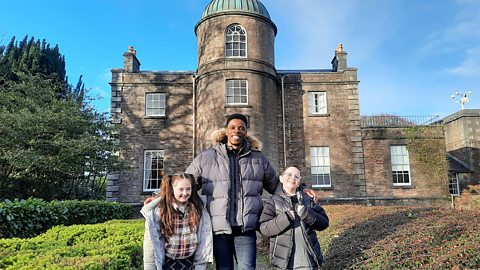Rhys is in Belfast to consider tourism, including the possible positive and negative impacts of tourism.
Rhys: This is Belfast, the capital city of Northern Ireland. Millions of tourists visit every year, and today IÔÇÖm one of them. IÔÇÖm exploring the city by bus!
Tourism is when people travel from where they live to another place for pleasure or relaxation. This can be a day trip or a few days holiday.
Later locals Anna and Oisin will be joining me on my adventure, as we explore the ruins of Dunluce Castle. But firstÔÇŽ LetÔÇÖs zoom outÔÇŽ
WeÔÇÖre in Northern Ireland. A popular tourist attraction here is the GiantÔÇÖs Causeway ÔÇô an ancient volcanic rock formation.
In England, lots of people visit the British Museum. In Scotland, the National Museum of Scotland is really popular. And in Wales, the Millennium Centre usually gets over a million visitors a year.
Tourist attractions can range from human-built places of interest like galleries and water parks, to natural places like lakes, mountains, or in the case of Northern Ireland, the famous Causeway coastline.
Wow, IÔÇÖm here!
Across the globe, tourism has increased over the years. There are many different reasons for this includingÔÇŽTravel has become easier, cheaper, and many people have more disposable income.
You can find out about places to visit more easily by researching online or watching videos. Ooooh!
And a lot of workplaces today offer more holiday time for staff than in the past.
There are different types of tourism, such as relaxing on a sunny beach, cultural visits to historic cities, active adventure trips, or enjoying places of entertainment.
Oisin and Anna have joined me at Dunluce Castle. IÔÇÖve asked them to help me make a tourist video of my trip as we explore the castle grounds.
3, 2, 1ÔÇŽ Say castle!
Children: Castle!
Rhys: IÔÇÖm loving being a tourist today! What do you think is the best thing about being a tourist?
Child: That I get to explore new places, new countries, new landmarks.
Rhys: And what do you think are some of the positive impacts of tourism?
Child: They spend their money in different shops and like the movies or somewhere and then that gives money to all the local businessÔÇÖ and keeps them up and running.
Child: More jobs for the local people in the area so they can earn more money.
Rhys: Yes, very good examples. It could also mean better services and facilities are built like roads and leisure complexes. And what do you think are some of the negative impacts of tourism?
Child: People will come and they wonÔÇÖt understand the rules of that and they will come and theyÔÇÖll throw litter down.
Child: Sometimes when tourists come thereÔÇÖs a lot of traffic and like everyday things take a lot longer because thereÔÇÖs so much traffic.
Rhys: Yes, absolutely. The key thing here is that tourism can be good if itÔÇÖs done in a sustainable way.
Ok, time to compareÔÇŽ London is the most visited city in the UK with over 20 million visitors per year. One of the most visited cities in the world is Hong Kong - where in recent years there have been an average of over 55 million visitors per year. ThatÔÇÖs the same as the number of people living in England!
So, what tourist attractions exist near you? Can you find any that youÔÇÖve never been too before? A unique building or an area of natural beauty?
Zoom in and have a look for yourself!
Do either of you know where the gift shop is? WhatÔÇŽ? GuysÔÇŽ?
Video summary
Rhys is in Belfast, the capital city of Northern Ireland, being a tourist and finding out about sustainable tourism.
Rhys explains how there are different types of tourist attractions from human-built places of interest - like a gallery - to natural places - such as lakes and mountains. He considers some of the different types of tourism: relaxing on a sunny beach, cultural visits to historic cities, active adventure trips, or enjoying places of entertainment.
Rhys is joined by two children and together they consider the positive and negative impacts of tourism and how itÔÇÖs important that tourism should be sustainable.
Teacher notes
Questions to consider:
- What is tourism?
- Have you ever been a tourist in the UK or abroad? What did you visit, where did you go, and what was it like?
- What do you think is the best thing about being a tourist?
- How does being a tourist make you feel? Is it different from ÔÇśnormalÔÇÖ life?
- Where would you like to go on holiday in the UK/abroad?
- Can you think of some different types of tourist attractions? What type is your favourite or would you most like to visit?
- How might tourism be different in a city or urban environment, compared to in a rural place?
- Why has tourism increased over the years?
- What are the positive impacts of tourism?
- What are the negative impacts of tourism?
- Why do you think people have different opinions on tourism?
- How do you think tourism can be done in a sustainable way?
- Should there be places on Earth where there is no tourism allowedÔÇŽ and if so why and where?
Suggested activities to further explore learning:
1. Plan a walking tour
Imagine tourists are coming to visit your local area. Plan and design a walking tour that youÔÇÖd take them on:
- What key sites, landmarks, places of interest, or viewpoints would you take them to?
- Would you plan any stop off points for the tourists to try some local food or drink? Or perhaps a nice spot where they could have a picnic?
- How will you choose the route - the quickest, the most scenic, the flattest, the quietest, or perhaps a combination?
- Will everyone be able to access the route - including those with pushchairs and wheelchairs? Will there be a longer and shorter option for different people with different amounts of time?
- Will there be any activities as part of the walking tour? A quiz about the local area, a photo opportunity moment, a chance to have a go at sketching a famous landmark in the area
- How will you make sure your tour is promoting sustainable tourism? For example, making sure itÔÇÖs not harming the environment, or helping support local businesses._
2. Brand new tourist attraction:
A large waterpark is being built in a quiet rural community as part of a new tourism plan for the area:
- Pupils are put into groups and assigned a character role. For example, a local business owner who runs a caf├ę, an elderly person living at a nearby care home, a young person trying to get their first summer job, an environmental officer specialising in wildlife protection.
- Each group creates a name, persona and biography for their character. The groups then consider and discuss the different viewpoints of their character on the new waterpark proposal ÔÇô how will it affect them? Will they experience positive or negative impacts? What suggestions do they want to make?
- Pupils draw an image of their character and write out the different views, concerns, and positive points for their person around the edge of the paper, ready to present to the class.
- This could be run as a debate where the children get a vote at the end - firstly in role as their character, and then a second vote as themselves. This activity can work extremely well if it is based on a real proposal close to your school - this might be more focused on development than tourism but then afterwards you could discuss a similar hypothetical proposal that is themed more closely to tourism.
The idea here is to get pupils thinking about the different perspectives and opinions surrounding tourism, to listen to one another, and to think of solutions that take all viewpoints into consideration.
| Key terminology | What it means |
|---|---|
| Disposable income | How much money a person has to spend or save after paying their everyday expenses such as energy bills, food, transport etc. |
| Environmentally friendly | Goods or services that have little or no negative impact on the environment, locally or globally. |
| Pollution | When harmful materials or substances are released into the environment. There are three main forms of pollution: air, water, and land, although in cities noise and light pollution can also be impactful. |
| Rural | Countryside areas which may contain scattered villages and small towns. Traditionally they would have supported farming communities. |
| Sustainable tourism | This is when tourism can continue long term without any lasting negative effects. Tourism can be made more sustainable, for example, by protecting the natural environment, preserving local culture, and creating benefits for the local community. |
| Tourism | When people travel from where they live to another place for pleasure or relaxation. This can be a day trip or a few days holiday. |
| Tourist attraction | Places where tourists come to visit. Tourist attractions can range from human-built places of interest like galleries and water parks, to natural places like lakes or mountains. |
| Trade | The buying and selling of goods and services. Cities are often especially busy areas of trade. |
| Traffic | The movement of vehicles along transport routes. |
| Urban | A built up area, cities and towns, where people live and work closely together. |
| Disposable income | How much money a person has to spend or save after paying their everyday expenses such as energy bills, food, transport etc. |
| Environmentally friendly | Goods or services that have little or no negative impact on the environment, locally or globally. |
| Pollution | When harmful materials or substances are released into the environment. There are three main forms of pollution: air, water, and land, although in cities noise and light pollution can also be impactful. |
| Rural | Countryside areas which may contain scattered villages and small towns. Traditionally they would have supported farming communities. |
| Sustainable tourism | This is when tourism can continue long term without any lasting negative effects. Tourism can be made more sustainable, for example, by protecting the natural environment, preserving local culture, and creating benefits for the local community. |
| Tourism | When people travel from where they live to another place for pleasure or relaxation. This can be a day trip or a few days holiday. |
| Tourist attraction | Places where tourists come to visit. Tourist attractions can range from human-built places of interest like galleries and water parks, to natural places like lakes or mountains. |
| Trade | The buying and selling of goods and services. Cities are often especially busy areas of trade. |
| Traffic | The movement of vehicles along transport routes. |
| Urban | A built up area, cities and towns, where people live and work closely together. |
Suitable for teaching geography at KS2 in England, Wales and Northern Ireland, and 2nd level in Scotland.
Food, farming and agriculture. video
Exploring farming and agriculture - a key UK industry. Includes arable, pastoral and mixed farming and examples of rural and urban farms.
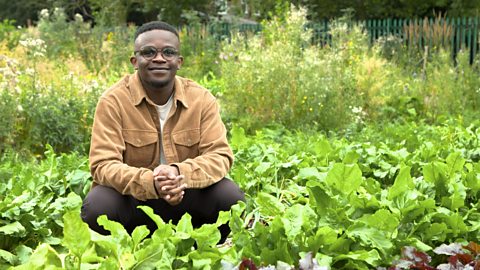
Urban settlements - living in a city or megacity. video
Exploring key aspects of cities and megacities - building use, population density, environmental impact and sustainable choices.

Coasts and sustainable use of natural resources. video
Examining a coastal region of North Wales, including a local wind farm and examples of the sustainable use of natural resources.
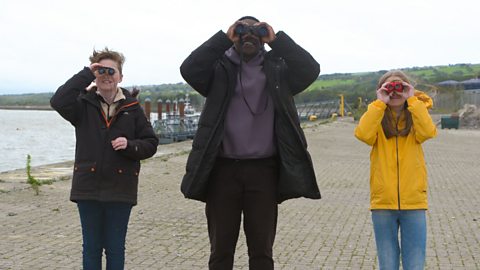
Rivers - the course of a river from source to mouth. video
Exploring the key aspects of rivers - the source, tributaries, streams, meanders, ox-bow lakes, river mouth and estuary.
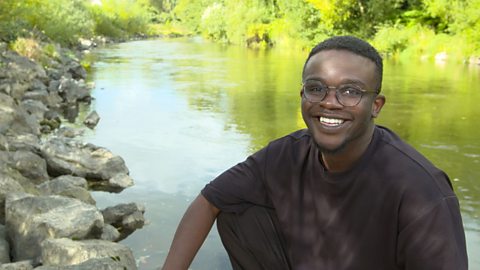
Mountains - how tectonic plates create mountain ranges. video
Exploring how tectonic plate movement creates mountains where the plates collide and single peaks formed by volcanoes.
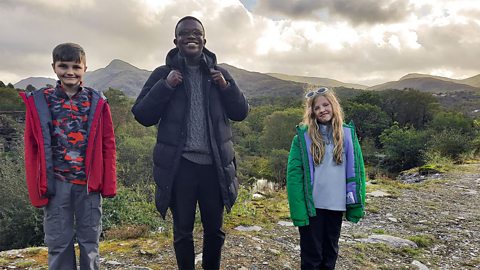
Lakes, lochs, reservoirs and the water cycle. video
Visiting Lake Windermere to consider lakes, lochs and reservoirs and their place in the water cycle.
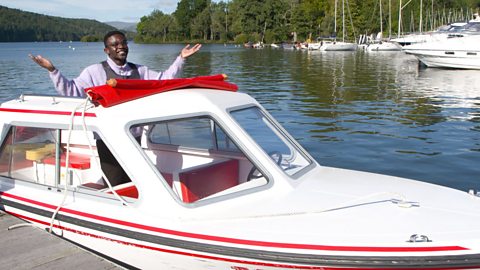
Forests - deciduous and coniferous woodland and biodivsity. video
Exploring a forest region in the Lake District to discover the rich biodiversity of woodland habitats.
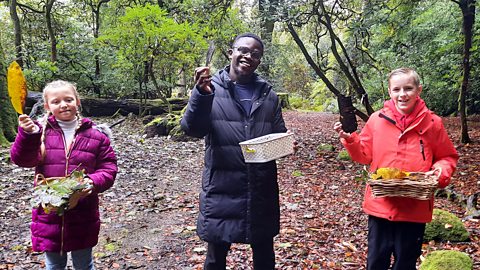
Shore, coast and ocean. video
Visiting a marine reserve in Scotland to discover the biodiverse habitat it offers, but also the importance of conservation.
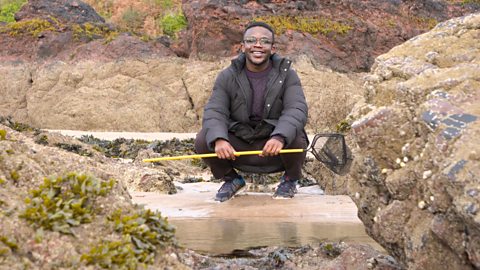
Peatlands, wetlands and the carbon cycle. video
Exploring the significance of peatland and wetland habitats to store water and absorb carbon or CO2.

UK settlements and navigating using maps. video
Exploring the different types of settlement in the UK - including villages, towns and cities - and how to navigate using maps, including symbols, compass points and co-ordinates.
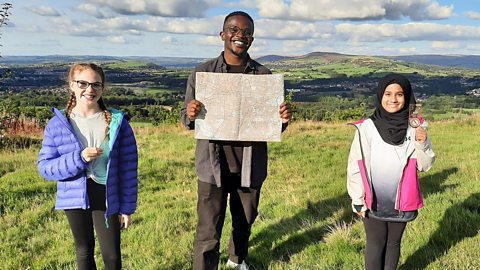
Weather and climate. video
Identifying seasonal and daily weather patterns in relation to the Equator and analysing the difference between weather and climate.
